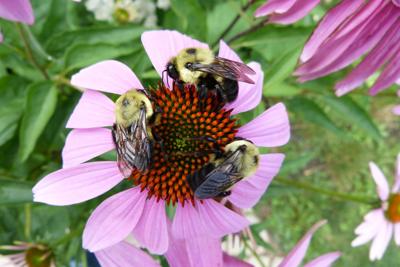The honey flow is on — what could possibly go wrong?
Many things affect the quantity and duration of the honey flow. In our area, the blooms that provide us with this liquid gold are only available for a short time.
On days like we have experienced recently with strong winds, bees will not fly as they could be thrown off course and not make it back home. On rainy days, bees remain in the wind. The rains can wash the blooms of nectar and the wind can knock the blooms off the plant at the same time.
We have had times in the past where it has rained every third day for an extended period. We have had years when especially large blooms like tulip poplar have covered the ground. Losing these days to make honey when a bee only makes one-twelfth of a teaspoon of honey in its life can certainly influence the honey production. Our major honey production is between mid-March and the first of June. There are areas of the country with a much longer period of time for honey production and they generally have large quantities of clover and other sources.
Most of our honey in our area comes from trees. Some of the major trees are tulip poplar, American holly, black gum and tupelo. Blackberry will also appear in everything. In some areas of our region, we get some summer production from cotton and soybeans. Everything that blooms is not good for honeybees. Azaleas, mountain laurel, rhododendrons and yellow jasmine are highly toxic. If you observe these plants, you will see that bumblebees and carpenter bees enjoy the pollen with no ill effects.
Honeybees do not drill holes in your house; however, carpenter bees do drill holes in your house. They also drill holes in dead limbs which will fall to the forest floor. They find a piece of wood they like and bore a three-eights inch hole where they will lay eggs and place a pollen patty to cover them where they will be fed. They resemble a bumblebee, but upon closer inspection it will be revealed they have a slick abdomen where a bumblebee's abdomen is completely covered with hairs. Carpenter bees are also good pollinators for your gardens.
There are traps for sale on marketplace, the market bulletin and Wagener Milling to mention a few that can be used to try and keep carpenter bees from drilling holes in your house.
Swarms are a normal way to populate an area. Catching the swarm can lead to two hives. With two small hives trying to build up, you will be lucky to get half of the honey production that one large hive could produce. Swarm control is one area that beekeepers have control over.
No matter how long you have been doing this as a beekeeper, the smell of the fresh honey turns all of your senses on. People will ask which is better the dark or the light honey. Color will vary from year to year, whereas the flavor is controlled by the floral source. Which one is best is something you determine.



